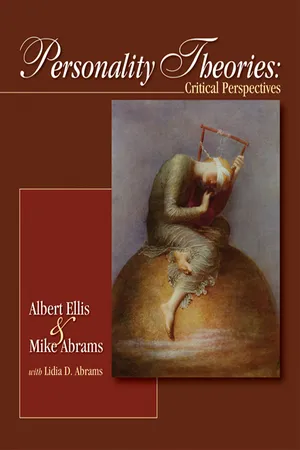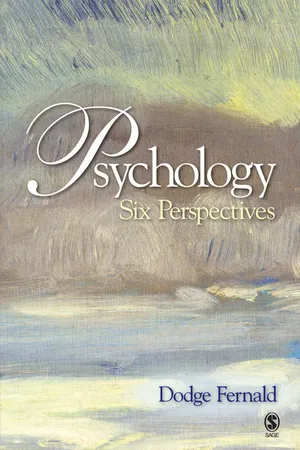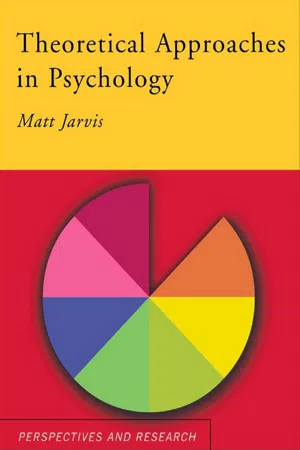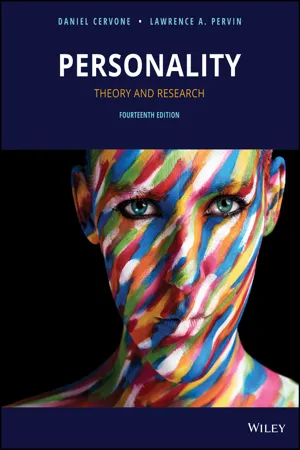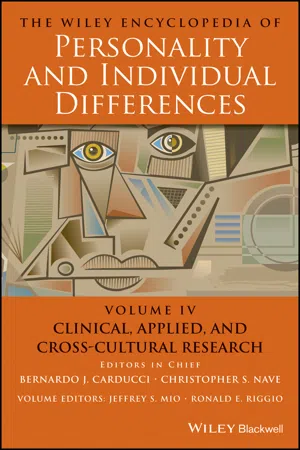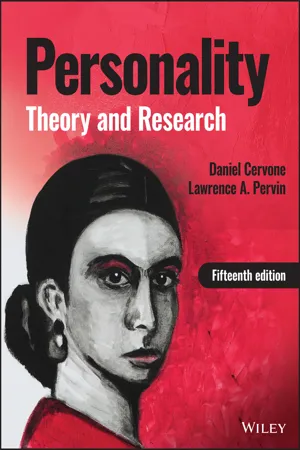Psychology
Humanistic Theory of Personality
The Humanistic Theory of Personality emphasizes the individual's capacity for personal growth, self-awareness, and self-fulfillment. It focuses on the importance of subjective experiences and the role of free will in shaping behavior. This approach highlights the positive aspects of human nature and the potential for individuals to strive towards self-actualization.
Written by Perlego with AI-assistance
Related key terms
1 of 5
12 Key excerpts on "Humanistic Theory of Personality"
- eBook - PDF
- Richard Ryckman(Author)
- 2020(Publication Date)
- Cengage Learning EMEA(Publisher)
P A RT 5 Humanistic/Existential Perspectives The theories considered in this section of the text are part of the third-force move- ment in contemporary psychology. (The other two movements are psychoanalysis and behaviorism.) The term was coined by Abraham Maslow (Chapter 12) to describe a position that focuses on the creative potentialities inherent in human beings and that seeks ways to help them realize their highest and most important goals. Virtually all of the humanistic theories postulate the existence of an innate growth mechanism within individuals that will move them toward realization of their potentialities if environmental conditions are right. This growth process has been variously labeled by its numerous proponents as the drive toward self- actualization, self-realization, or selfhood. The roots of the humanistic movement can be found in the writings of Jung, Adler, Horney, Kohut, Allport, Maslow, Rogers, May, and others. These theorists all emphasize the uniqueness of individuals and believe that all individuals should be free to make their own choices about the direction they want to take in their own lives. People should be allowed to organize and control their own behavior; they should not be controlled by society. Society is generally seen as the “bad guy,” the enforcer of rules and regulations that stifle personal growth. According to the humanists, a benevolent, helpful attitude toward people allows them to grow and prosper. Most societies, they believe, attempt to coerce indivi- duals into behaving appropriately, that is, normally. The result is rather dull, conventional people who usually obey, without much question, the moral pre- scriptions of the majority. In other words, the result is the average, law-abiding man or woman. The humanistic psychologists argue, instead, for allowing individuals to develop to their fullest potential. They see people as naturally striving to be crea- tive and happy rather than mediocre and conventional. - eBook - ePub
Personality Theories
Critical Perspectives
- Albert Ellis, Mike Abrams, Lidia Abrams(Authors)
- 2008(Publication Date)
- SAGE Publications, Inc(Publisher)
Chapter 11Humanistic Views of Personality
Chapter Goals- Outline the development of the humanistic school in psychology
- Show how humanism came into being, in part as a response to the pessimistic concepts of psychoanalysis and the mechanistic methods of behaviorism
- Explain the importance and role of Abraham Maslow in the humanistic movement in psychology
- Trace the growth of the existential movement in psychology and detail its connection to humanism
- Explore both the strengths and weaknesses of humanistic psychology in explaining human personality
T he fact that we speak at all of a humanistic approach to psychology leads to an obvious question: Why did some psychologists feel this approach was necessary? After all, to propose a humanistic approach to psychology implies that psychology in its essence is not concerned with human beings. In fact, this was precisely the point the early humanist psychologists were making.By the middle of the 20th century, psychiatry was dominated by psychoanalytic views of personality as well as of mental pathology. The leading school of thought in the field of psychology itself was behaviorism, which was taught and practiced in most universities and clinical centers, especially in the United States. A majority of psychologists approached all organisms, including humans, in terms of their responses to stimuli. Such internal events as thoughts and emotions were considered to be irrelevant to psychology. They could neither be observed nor directly tested; thus, including them in analyses of human nature was considered unscientific. This restriction led some psychologists to find the dominant view far too limiting. They maintained that behaviorism had eliminated some of the most important dimensions of the human psyche. This point of view had been indirectly supported in an earlier generation by such psychologists as Max Wertheimer, Kurt Koffka, and Wolfgang Köhler. These theorists are generally credited with developing the Gestalt (from the German word for form or shape - eBook - PDF
- Nancy Ogden, Michael Boyes, Evelyn Field, Ronald Comer, Elizabeth Gould(Authors)
- 2021(Publication Date)
- Wiley(Publisher)
However, humanistic theories have had a pervasive influence on the field of psychol- ogy. As mentioned above, and elsewhere in the textbook, researchers in positive psychology are giving new attention to questions about how human beings can achieve their full potential for hap- piness. It remains to be seen how humanistic psychology will contribute to this ongoing discussion. Before You Go On (Answers to Before You Go On may be found online in the Course Resources.) What Do You Know? 5. What is self-actualization? 6. According to Rogers, what happens if children fail to regularly receive unconditional positive regard? 7. What is a key criticism of humanistic theory? What Do You Think? • What do you think are the key qualities of a fully self-actualized person? Who might match your characterization? The Trait Perspective LEARNING OBJECTIVE 3 Summarize the leading trait theories, and describe how the five-factor theory has evolved from the work of Gordon Allport and Hans Eysenck. The units or building blocks that personality psychologists use to describe personalities are called traits. On one level, traits are simply terms (adjectives) used to describe people. Table 12.3 contains some examples of personality trait terms. From the list, see if you can find one word that best describes who you are, over a wide variety of situations. Chances are good that you know people who provide examples of each of these traits. Personality traits are stable characteristics or qualities that people show in a variety of situations over a long period of time, even a lifetime. They describe our tendencies to act in a particular way. personality traits tendencies to behave in certain ways that remain relatively constant across situations. - eBook - PDF
Psychology
Six Perspectives
- Dodge Fernald(Author)
- 2007(Publication Date)
- SAGE Publications, Inc(Publisher)
6 Humanistic Psychology Rise of Humanistic Psychology Rogers and Growth Potential Protest of the Third Force Three Human Characteristics Subjectivity: The Basic Reality Individuality and Self Theory The Capacity for Growth Influence of Early Experience Conditions of Worth Congruence and Incongruence Philosophical and Practical Issues The Question of Free Will Existentialism in Daily Life Toward a Positive Psychology Person-Centered Therapy A Growth-Inducing Environment Facilitating Self-Exploration Commentary and Critique 175 H umanistic psychology offers an optimistic outlook on the human condition. Its popularity arises substantially from its emphasis on our inborn potential for favorable growth. If not obstructed by the environment, this capacity emerges in the choices people make for achieving fulfillment in day-to-day living. Under appropriate therapeutic conditions, it also engen-ders self-healing and recovery from psychological problems. In the best and worst of times, human beings possess an inborn capacity for growth and fulfillment. After surveying the origins of humanistic psychology, this chapter turns to three characteristics of being human; then it examines selected concepts about early experience in human life; and later it addresses philosophical and prac-tical issues. Collectively, these discussions show how humanistic psychology stands apart from mainstream psychology. It includes nomothetic interests but concentrates prominently on the individual human being, sometimes from the viewpoint of that person’s experience. This focus on the individual and on subjectivity holds true in humanistic therapy as well, a discussion that appears before the closing commentary and critique of this perspective. With these concerns, humanistic psychology presents an open approach to psychological questions, often addressing unusual case studies and elusive concepts that are difficult to operationalize. - eBook - PDF
- Ronald Comer, Elizabeth Gould, Adrian Furnham(Authors)
- 2014(Publication Date)
- Wiley(Publisher)
Further, the evidence for the efficacy of the therapies recommended by humanistic psychologists has not been very impressive. However, humanistic theories have had a pervasive influence on the field of psychology. As we have men- tioned, researchers in positive psychology are giving new attention to questions about how human beings can achieve their full potential for happiness. It remains to be seen how humanistic psychology will contribute to this ongoing discussion. The Trait Perspective LEARNING OBJECTIVE 3 Summarize the leading trait theories, and describe how the five-factor theory has evolved from the work of Gordon Allport and Hans Eysenck. Suppose you were asked to describe your best friend’s per- sonality. What would you say? You may use words such as funny, caring and outgoing. Indeed, one study revealed that there are 18,000 words to describe personality in the Eng- lish language (Allport & Odbert, 1936). Many of these words describe personality traits. Many are considered very posi- tive, like sincere, loyal and truthful; others are considered very negative, like cruel, mean and phoney. Indeed, the Lexi- cal school of personality psychologists seeks to understand personality by looking at the structure of personality words in different languages. The idea is that words have developed to describe the very basic behavioural traits that have been observed over the centuries in all cultures. Personality traits are tendencies to behave in certain ways that remain relatively constant across situations. Personality traits describe our general dispositions, and those dispositions, in turn, lead to our behaviours. If people are generally enthu- siastic, for example, they may show enthusiasm by doing their homework with gusto or singing as they walk down the street. We can describe personality traits at different levels: as a trait/domain (i.e. extraversion) or as a facet (activity, sociability, risk taking) or a habit (going to parties, playing practical jokes). - eBook - ePub
- Matt Jarvis(Author)
- 2005(Publication Date)
- Routledge(Publisher)
- Humanistic psychology has given us a simple, accessible and effective model of counselling. This has meant that many more people have access to psychological help than would probably be the case otherwise.
- Perhaps most importantly, humanistic psychology is alone in the major psychological approaches in emphasising the positive aspects of human nature and adopting a thoroughly positive attitude to humanity.
Despite these contributions, it is almost certain that humanistic psychology will remain a subversive element in psychology rather than part of mainstream psychology. Some of the major limitations of a humanistic approach are as follows:- To an even greater extent than the psychodynamic approach, humanistic psychology has generated theories and ideas that have proved very difficult to test by scientific investigation.
- Because the subject matter of humanistic psychology is the experience of the individual person, there is a logical problem of applying theories generated from one individual to another. We cannot for example assume that two people experience the same thing when they speak of a peak or spiritual experience.
- Many humanistic ideas (particularly those around the development of the self) are extremely culture bound, and cannot easily be applied to a range of societies or historical periods.
- The humanistic emphasis on the individual person means that the importance of external influences on people’s lives have probably been underestimated. As Lerman (1992) has pointed out, a battered wife can learn through humanistic psychology that she has a right not to be abused, but it does not in itself allow her to leave the situation safely.
Summary
Humanistic psychology emerged through the work of Rogers and Maslow, who sought to create a third force in psychology to escape the restrictions of behavioural and psychodynamic psychology. They proposed a simple and optimistic psychology with a minimum of theory that would address what people described as important experiences. The major application of humanistic psychology is in counselling, where the experience of the individual is of paramount importance. Although the humanistic perspective remains important, it has limited influence in psychological research because of its untestable ideas and emphasis on the experiences of the individual. - eBook - PDF
Personality
Theory and Research
- Daniel Cervone, Lawrence A. Pervin(Authors)
- 2018(Publication Date)
- Wiley(Publisher)
As a theorist, his overarching goal was to develop a framework to explain the nature and development of the self as the core element of personality. Rogers’s phenomenological self-theory can also be described by another term: humanistic. Rogers’s work is part of a humanistic movement in psychology whose core feature was to emphasize people’s inherent potential for growth. This chapter, then, introduces you to the theory—the phenomenological, human- istic, self-theory—that is the enduring legacy of one of the great American psycholo- gists of the 20th century, Carl Rogers. A PHENOMENOLOGICAL THEORY 128 Questions to be Addressed in this Chapter 1. What is the self, and why might one not act in a manner consistent with one’s true self? 2. Freud viewed motivation in terms of tension reduction, the pursuit of pleasure, and intrapsy- chic conflict. Is it possible to view human motivation, instead, in terms of personal growth, self-actualization, and feelings of congruence? 3. How important is it for us to have a stable self-concept? How important is it for our internal feelings to match our self-concept? What do we do when feelings are in conflict with our self-beliefs? 4. What are the childhood conditions that produce a positive sense of self-worth? In the previous chapters, you learned about Freud’s psychoanalytic theory of personality and related psychodynamic positions. We now introduce a second, entirely different perspective. It is that of the American psychologist Carl Rogers. His work exemplifies a phenomenological approach to the study of persons. At the outset, you should consider how these conceptions, Freud’s and Rogers’s, are related. Rogers did not disagree with everything Freud said about persons. He recognized that Freud provided some insights about the workings of the mind that are of enduring value. Also, Rog- ers worked in a style that was similar in some ways to that of Freud. - eBook - ePub
- Fay Short, Phil Thomas(Authors)
- 2014(Publication Date)
- Routledge(Publisher)
Chapter 2Humanistic approach and person-centred therapyCHAPTER CONTENTS• Introduction to humanistic approach and person-centred therapy• Development of the humanistic approach– Third force in psychology– Major advances in the humanistic approach– Key figures in the humanistic approach• Personal and professional biographies of Carl Rogers and Abraham Maslow– Biography of Carl Rogers– Significant learnings– Biography of Abraham Maslow– Significant learnings of Abraham Maslow• Humanistic theories of human nature and personality– Organismic self and self-concept– Impact of conditions of worth on the self-concept– Tendency towards self-actualisation– Hierarchy of needs– Characteristics of the fully functioning person– Nineteen propositions of personality• Therapeutic relationship in person-centred therapy– Six conditions for constructive personality change– Necessary and sufficient?– Stages of constructive personality change– Relational depth• Therapeutic techniques in person-centred therapy– Absence of techniques– Demonstrating congruence– Demonstrating unconditional positive regard– Demonstrating empathic understanding• Case study demonstrating person-centred therapy– Recorded session: therapy in action– Presentation of Phil Thomas: history and symptoms– Therapy session: analysis– Personal experience of the clientINTRODUCTION TO HUMANISTIC APPROACH AND PERSONCENTRED THERAPY
This chapter aims to introduce the reader to the humanistic approach to counselling and psychotherapy. Person-centred therapy will be explored as one example of a therapeutic method under the humanistic approach. - (Author)
- 2020(Publication Date)
- Wiley(Publisher)
Rogers (1987) once noted: “I must constantly resist the temptation to rush in and fix things.” Given the present enormous variety of therapeutic approaches, the application of Humanistic Psychology stands out as one that functions to empower clients rather than fix them. Powerful people will make appropriate decisions to fix themselves. A phrase that has been used in educating therapists is: “If we do our job well, we do ourselves out of a job.” J. F. T. Bugental, AHP’s first president, called the humanistic emergence ‘The Third Force’ in psychology. He noted that human beings are intentional, aim at goals, are aware that they cause future events and seek meaning, value, and creativity (Bugental, 1964). Clinical Applications of Humanistic Theory of Personality 36 See Also Abraham Maslow Carl Rogers Clinical Applications of Humanistic Theory of Personality Clinical Applications of Psychodynamic Theory of Personality References Adler, A. (1935). The New York Times, Sept. 7. Anderson, W (1970). Politics and the new humanism . Pacific Palisades, CA: Goodyear Publishing. Bugental, J. F. T. (1964). The third force in psychology. Journal of Humanistic Psychology , 4(1), 19–25. Casals, P. (1970). Joys and sorrows, reflections . New York: Simon and Schuster. Charnofsky, S. (1997). M. E. L. T: A therapy of optimism. The Networker (A newsletter of the Marriage and Family Therapy Program at California State University, Northridge), 1(1). Descartes, R. (1637). Discourse on the method of rightly conducting the reason, and seeking truth in the sciences. pp. 19–20. Glasser, W. (1938). Choice theory: A new psychology of personal freedom . New York: Harper Collins. Jackins, H. (1977) The upward trend: A collection of writings on reevaluation counseling . Seattle, WA: Rational Island. Levant, O. (1968). The unimportance of being Oscar . New York: Putnam. Maslow, A. H. (1954). Motivation and personality . New York: Harper. Ofman, W. (1976). Affirmation and reality .- eBook - PDF
Personality
Theory and Research
- Daniel Cervone, Lawrence A. Pervin(Authors)
- 2022(Publication Date)
- Wiley(Publisher)
Consider the others (all of which were overviewed in Chapter 1). In psychodynamic theory, the psychological core of personality is not a conscious self that you reflect upon. It’s a set of unconscious mecha- nisms that you cannot reflect upon. In behaviorism, any answer you give to the question “What do you think of yourself?” is, itself, merely a behavior. There is no distinctive “self” for you to contemplate. In the trait theories, the traits, at their core, have little to do with the human sense of self. That is why the trait structures can be found also in animals (Gosling & John, 1999)—who have no human sense of self. Personal construct theory and the social-cognitive theories do recognize—and emphasize— that people develop a range of distinct beliefs, goals, standards of evaluation, and personal construct systems that center one or another feature of themselves. Yet even those theories devote little attention to the seemingly undividable, “holistic” entity that is you—your whole, unitary self. Might you be looking for a personality theory that does make this “whole self” its target of attention. If so, you’ve come to the right place: This chapter, which introduces you to phenom- enological personality theories and, especially, the personality theory of the American psycholo- gist Carl Rogers. Rogers provided a new theory of the person. It emphasized conscious perceptions of the pre- sent rather than unconscious residues of the past, interpersonal experiences encountered across Rogers’s phenomenological self-theory can also be described by another term: humanistic. Rogers’s work is part of a humanistic movement in psychology whose core feature was to emphasize people’s inherent potential for growth. This chapter, then, introduces you to the theory—the phenomenological, humanistic, self-theory—that is the enduring legacy of one of the great American psychologists of the 20th century, Carl Rogers. - eBook - PDF
- Jerry Burger(Author)
- 2018(Publication Date)
- Cengage Learning EMEA(Publisher)
Due to electronic rights, some third party content may be suppressed from the eBook and/or eChapter(s). Editorial review has deemed that any suppressed content does not materially affect the overall learning experience. Cengage Learning reserves the right to remove additional content at any time if subsequent rights restrictions require it. 272 Chapter 11 / The Humanistic Approach T: Logically, you realize that courage is one of your deficiencies, but inside yourself you find yourself laughing at that notion and feeling that it doesn’t really have anything to do with you. Is that it? C: That’s right. I always sort of make myself different. That’s it. (1947, pp. 138–140) Therapists never tell clients what the client really means to say. Instead, ther- apists restate what they believe they are hearing. However, these restatements are only suggestions for the client to agree with or reject. If the process is effective, cli- ents come to see themselves as others do and eventually accept or modify what they see. Clients may come to understand that they have been distorting or denying parts of their experiences. A man may realize he has been trying to live up to his father’s impossibly high expectations, or a woman may come to understand she is afraid to commit herself to a serious relationship. In the freedom provided by the therapist’s unconditional support, clients peel away their defenses, accept who they are, and begin to appreciate all of life’s experiences. Today a large number of psychotherapists identify their approach as humanistic (Cook, Biyanova, Elhai, Schnurr, & Coyne, 2010), and many others include aspects of person-centered therapy in their work (Cain & Seeman, 2002). - eBook - PDF
- Dennis M. McInerney, Herbert Marsh, Rhonda G. Craven(Authors)
- 2015(Publication Date)
- Information Age Publishing(Publisher)
Theory Driving Research, pages 109–133 Copyright © 2013 by Information Age Publishing All rights of reproduction in any form reserved. 109 CHAPTER 5 SELF-DETERMINATION THEORY AND ACTUALIZATION OF HUMAN POTENTIAL Edward L. Deci Richard M. Ryan Frédéric Guay INTRODUCTION The concept of human potential has been used most frequently within the tradition of humanistic psychology. Important early theorists such as Maslow (1943) and Rogers (1951) proposed that people have an inher- ent tendency toward growth and development, and that this tendency will, under the right circumstances (e.g., unconditional positive regard), lead people toward actualizing their human potential, which means to become all that they are capable of being. The idea of actualizing one’s potential implies that people are not relatively empty organisms who need to be con- ditioned (e.g., Skinner, 1953) or taught who they are through social inter- actions (e.g., Bandura, 1986). Rather, it begins with an organismic meta- theory, which assumes that people are inherently active, inclined by nature toward inner organization, and genetically endowed with characteristics and capabilities that will flourish when they are provided with the necessary nutrients within their social contexts. 110 E. L. DECI, R. M. RYAN, and F. GUAY The organismic meta-theory that underlies the humanistic perspective is linked with broader theories of life science (e.g., von Bertalanffy, 1968) and biology (e.g., Kauffman, 2000; Mayr, 1982) in which individuals are viewed as inherently active and self-organizing. This assumption is also shared by some developmental theories (e.g., Piaget 1952, 1971; Werner, 1948) that have focused on the active and integrative nature of developing persons (Deci & Ryan, in press). As well, self-determination theory (SDT; Deci & Ryan, 2000; Ryan & Deci, 2000) was built upon a set of organismic meta- theoretical assumptions.
Index pages curate the most relevant extracts from our library of academic textbooks. They’ve been created using an in-house natural language model (NLM), each adding context and meaning to key research topics.

